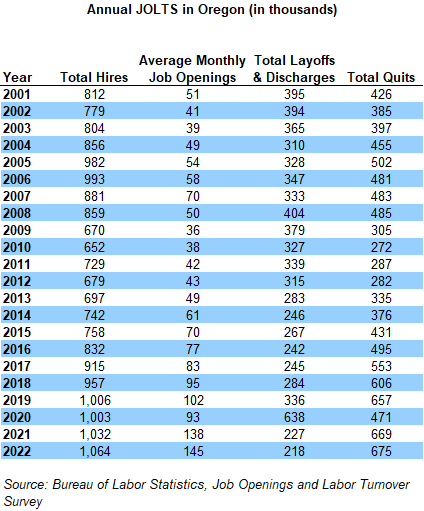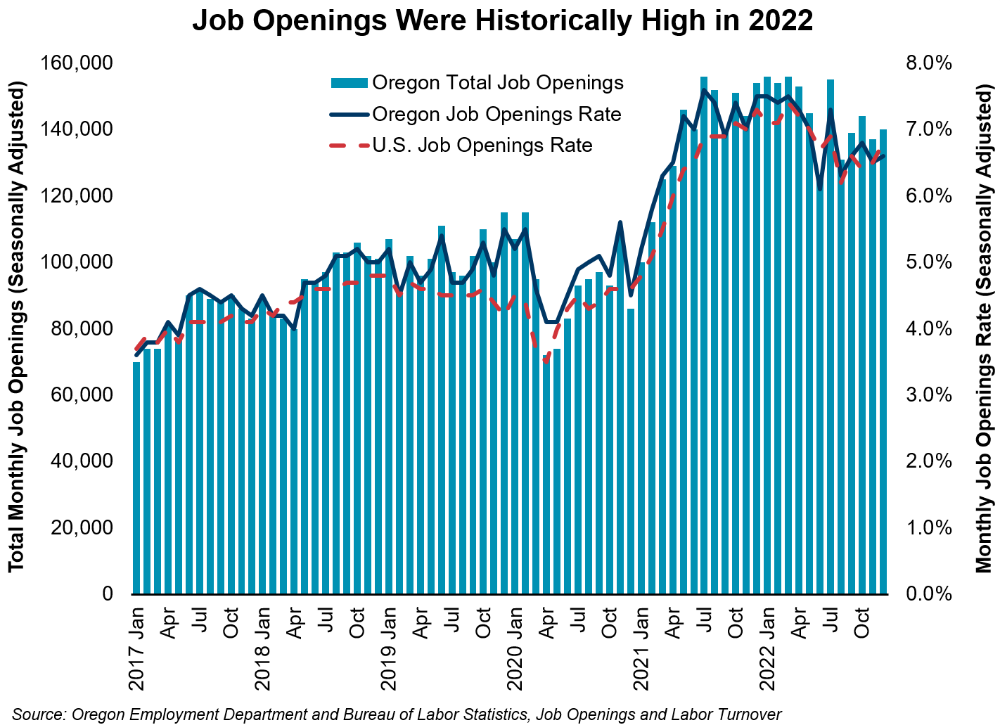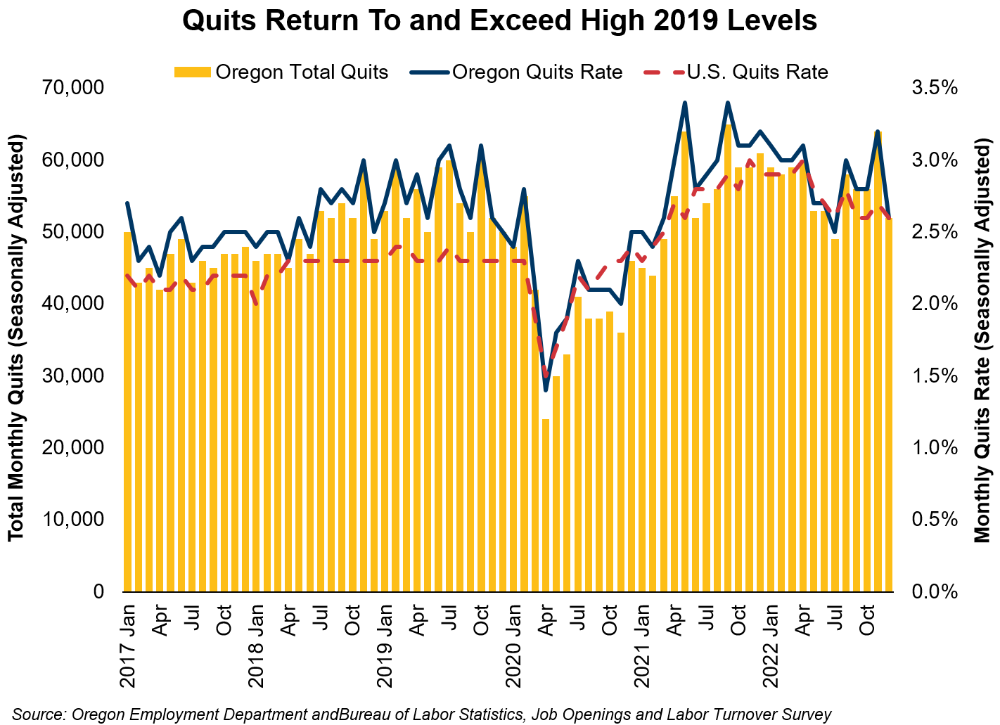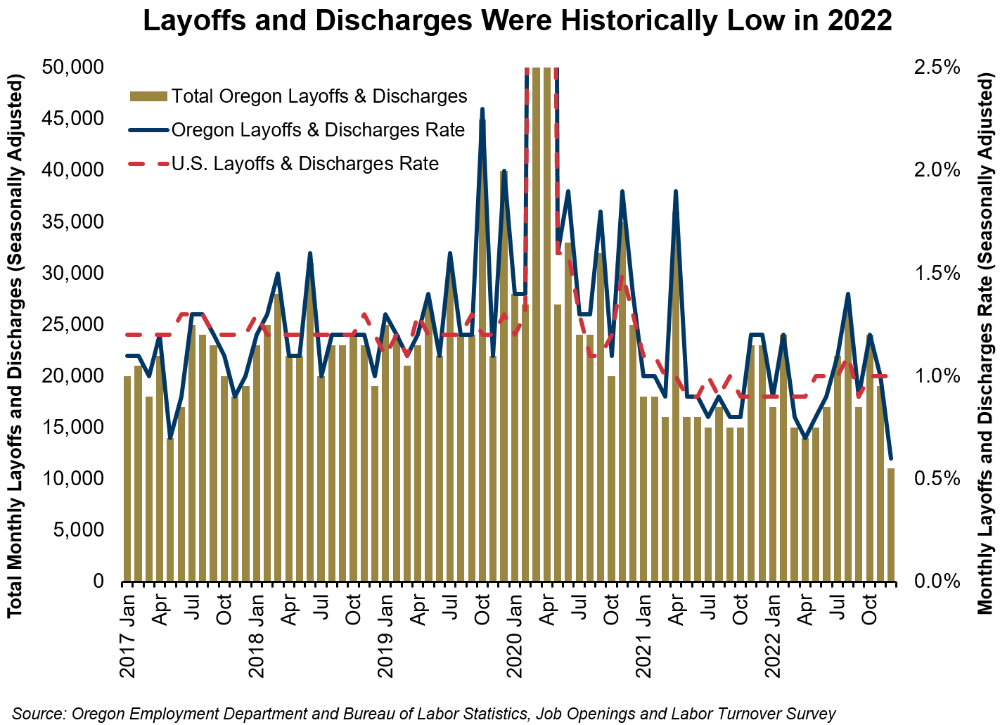Oregon Labor Market Gets a Jolt: JOLTS in Oregon
August 21, 2023Labor demand in Oregon was red hot in 2022. Data from the Bureau of Labor Statistics (BLS) showed that Oregon recorded most annual hires and job openings ever since the data was first tracked in 2001. With high labor demand, workers sought out other job opportunities which resulted in record high quits, which itself fed back into more job openings and hires. The tight labor market and difficulty in hiring led firms to lay off fewer people, as layoffs and discharges were at their lowest level ever.
This labor market data come from the BLS’s Job Openings and Labor Turnover Survey (JOLTS). JOLTS is a monthly survey that is used to measure labor availability and demand through job openings, hires and separations. The BLS calculates national estimates using the national survey of 21,000 establishments. State-level JOLTS data, on the other hand is estimated mostly using models with national data as inputs, with limited information gathered specifically from Oregon businesses. More details on the BLS’s methods are available on their website.

Labor Demand was Red Hot in 2022
Annual total hires and average job openings both set record highs in Oregon in 2022. Annual total hires – defined as all additions to payroll – reached a record 1,064,000 in 2022. This is a 3% increase from 2021 (1,032,000 hires), and a 6% increase from 2019 (1,006,000), which was the pre-pandemic high. Within 2022, seasonally adjusted hires peaked in August with 114,000 hires, then dipped to 77,000 hires in December to close out the year.
The hiring rate (hires as a percentage of employment) was also at a very high at 4.5%. This is a slight decline from the rate of 4.6% in both 2020 and 2021. It is also slightly below the highest recorded hiring rate in Oregon of 4.9% in 2005.
The BLS estimates that there were a monthly average of 145,000 job openings – defined as a firm actively recruiting for a position that starts within 30 days – in Oregon in 2022. That is the highest annual average job openings level since the BLS started tracking job openings in 2001. The job openings numbers also represent a 5% increase from 2021 (138,000 job openings) and a 42% increase from 2019 (102,000), the pre-pandemic high. Seasonally adjusted job openings peaked in January and March in 2022 with 156,000 job openings, then declined finishing with 140,000 in December.

The job openings rate – the percentage of the job openings divided by the sum of employment and job openings – sat at 6.9%, its highest rate in the JOLTS series. The highest pre-pandemic rate was 5.0% in 2019.
The BLS’s job openings estimations tries to estimate the same thing as the Job Vacancy Survey published by the Oregon Employment Department (OED), but they slightly differ in methodology. While the BLS has only a national survey for both private and public sectors, OED surveys 16,000 private Oregonian employers to estimate job vacancies. On average in the last 10 years, BLS estimates around 30,000 more job vacancies than OED. For 2022, the difference is a bit more than previous years: OED estimated that there were 104,000 job vacancies at any given time in 2022, 41,000 less than the BLS’s estimation.
Separations: High in Quits, Low in Layoffs and Discharges
The sky-high demand for labor had two distinct effects on separations in the labor market in 2022. First, total annual quits were at the highest level ever recorded in Oregon as employees had unprecedented ability to seek other opportunities. Second, total layoffs and discharges tied for lowest levels ever and the lowest rate ever as employers tried to retain labor in a difficult hiring environment.
Quits hit the highest level ever in 2022 with 675,000 total estimated quits. The quits level is 1% higher than 2021 and 3% higher than 2019. Seasonally adjusted monthly quits remained fairly stable in 2022, usually remaining between 50,000 and 60,000 quits throughout the year.

The quits rate (quits as a percentage of employment) in 2022 was the second-highest ever at 2.9%, only behind 2021’s rate of 3.0%. The 2022 rate is also higher than the pre-pandemic high of 2.8% in 2019. Pre-2017, the highest annual rate was 2.5% in 2005.
Total layoffs and discharges in 2022 were the lowest in JOLTS history with only 218,000. The pre-2020 low was 242,000 in 2016. Seasonally adjusted monthly layoffs and discharges remained at consistent levels throughout the year, bouncing between 17,000 and 27,000 before plummeting to 11,000 at the end of the year.

The 2022 layoff and discharge rate was also the lowest ever at a rock bottom 0.9%. The pre-2020 low was 1.1% achieved in 2016 and 2017.
This all points to a side effect of the tight labor market. Because it is so difficult to hire labor in a tight labor market, firms are more hesitant to lay off or fire employees. This is especially noticeable when comparing 2022 to 2019: There were 37% fewer layoffs and discharges in 2022 than in 2019.